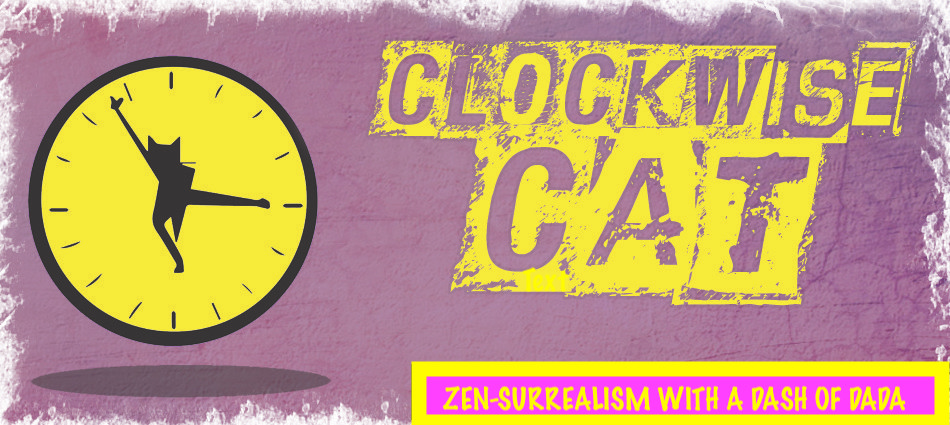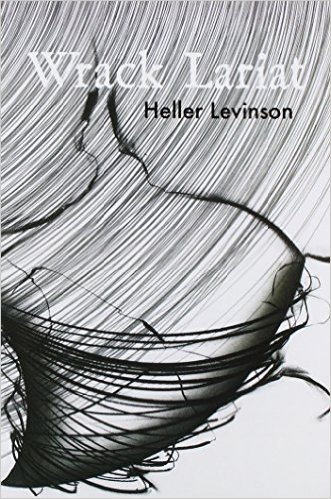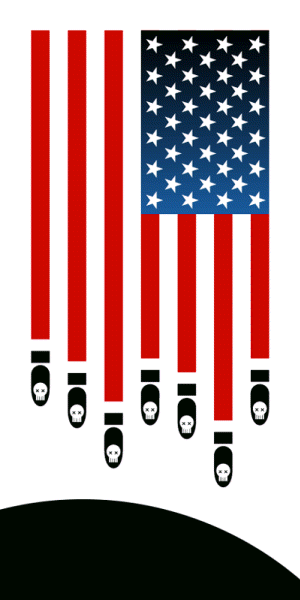
SCRIBEWISE CAT: HELLER LEVINSON AND WRACK LARIAT
The Carefully Constructed Chaos of Heller Levinson’s Wrack Lariat
by Alison Ross

Just thinking about writing a review about Heller Levinson’s Wrack Lariat frankly induces a bit of panic in me. Heller seems to inhabit another dimension altogether, a frenzied domain where language and ideas trippily transcend time’s pesky constraints, where they are given free reign to be as “unhinged” as they were innately meant to be. And although “unhinged” is perhaps the paradoxical antithesis to the word “hinge,” at least as Heller means it, the two words seem to have the same connotation.
Because, you see, Heller is the pioneer of Hinge Theory. As I understand it – and sometimes I think I do, and other times I am sure I don’t (Heller’s ideas are both elusive intellectually and yet intuitively sound) – Hinge Theory is a poetics that posits that words and ideas “hinge” on intrinsic associations, and these associations, once activated, propel a poem forward. Language acts as an artistic equation. Language is malleable mathematics, if you’ll permit the oxymoron. With Hinge Theory, language is both technically precise but also cosmically expansive.
(Of course, Heller may disagree with my flaccid interpretation of his grand theory, and I’ll just have to live with it.)
Wrack Lariat seems to take Hinge Theory to unfathomed extremes. When I reviewed Hinge Trio, which was a collaborative work between Felino Soriano, Heller Levinson, and artist Linda Lynch, my brain felt mightily befuddled with the labyrinthian language. After reading about half the poems in Wrack Lariat, it felt as though a category five cyclone had hurtled through my cerebrum. The frenetic energy, the tumultuous urgency of the verse – these were sensations not easy to shake off. I had to take a hiatus.
After my Heller hiatus, I returned more prepared to tackle the daunting dissection of Wrack Lariat so that I could place it into some sort of proper perspective. But then I realized, how does one sculpt coherence out of utter anarchy? And then I had an epiphany as I was finishing up the book: it’s only anarchic on the surface. Wrack Lariat is actually the product of deliberate control, where chaos is tightly contained within an orderly context. A tornado bouncing off the walls of an asylum. Hell, even Linda Lynch’s cover picture and the illustrations within hint heavily at twister activity. Elegantly woven whirlwinds.
Okay, so now I can do this.
I think.
Wrack Lariat is divided into ten sections, each with its own milieu. In the inaugural chapter, “How Much of / wHoosh,” Heller asks a series of rhetorical anti-questions, some absurd-seeming, but most with pointed purpose: “How much of commotion is arrangement misconstrued” (a fitting inquiry for his style of verse); “How much of earth-cunning is dig”; “How much of tongue is flappable”; “How much of circumstance is circumstantial”; and so on. These are interspersed throughout the section that teems with turbulent verse perhaps best epitomized in this poem, quoted in full:
nevertheless the preposterous has a way of gaining garnering gathering given the extremities subsequentialities galore glorify in underweight in the achievement of molasses spaghetti with marinara sauce sailing at full tide hardly a template to modify so many concerns alight the brow afflict scowl parsimony is a declining tautology a life of the mind a sacrosanct search for signature serious seriously
The rich wordplay in such poems, the alliterative and associative properties, is staggering to the point of discombobulation. Each poem’s surface illogic has a Jabberwocky-esque internal rationale, which noisily declares, “I make sense unto myself!” Each fragment of verse exists as a screaming statement against stagnation in poetry and art. Hence, the “whoosh” of each piece.
The next section’s title, “moreover hardly sometimes of if ever obviously,” recalls the cerebrally whimsical style of e.e. cummings, who clearly viewed language as his own giant intellectual toybox. Heller, too, is enamored of language’s perpetual possibilities; he is concerned primarily with molding his own linguistics, a sort of Chomskian poetics, where our brains are already hardwired with the template of such a feral vernacular, and Heller is just teasing it out of us.
Each poem in this section begins with a word from the title, and it moves sequentially. For example, some of the lines begin, “moreover & besides furthermore is no longer preposterous bearing deceased decadence”; “hardly original in his approach to procedure”; “sometimes you just have to step back a grain gain lawfulness”; “if ever you take a notion/lubricate with lotion”; “of if as pertaining to equality equidistance equilateral quasimatter”; and so on.
Each word spawns a new thought which races the poem forward in a dizzying motion, in a never-ending speed-induced tango across the floors of infinity.
Sections three through five are titled, “Corner of ____&_____,” “Four-Play” and “Gerundial Geist,” respectively. The corner poems investigate intersections between, among other topics, seemingly antithetical ideas, such as “Corner of Propaganda and Philanthropy,” or related emotional activities, such as “Corner of Ponder and Brood,” where “gestation” is “pensive/like/ fish/glued/to a malevolent tide.” The four-play poems are each – you guessed it – four lines, and explore mundane or minute abstract matters (parsimony, distances, realism, wilderness) in mock matter-of-fact or even deadpan ways:
relationships are composed of compromise. compromise entails giving in or giving up. elasticity is a prerequisite for compromise. compromise sucks.
The gerundial poems contain gerunds as the instigating lead-ins, as in “calculating sulk on dismissive freeways,” which imagines “ a drone in the garden of conspiracy,” and also in “cultivating lachrymal,” whose “in skeletal Unclutter this Nepenthe” culminates a brief series of inquiries about underdogs and outlaws.
If all of this is making your head swim in amused bemusement, you might be relieved to know that the next section, “Accidentals,” proclaims not to follow any particular pattern, but rather, is a collection of random “restlessnesses” plucked from the archives of Heller’s documents.
The problem is, these poems ultimately don’t provide any respite from the madness, despite the earlier perceived promise. Indeed, the verse in this section elevates the sense of lucid lunacy, as epitomized by the lengthy, restive, tonally capricious, “The Infra-Intra-Ultrapolational Migration.” This quasi-prose poem not only quotes Billie Holliday lyrics, but it manages to reference Rothko, children coloring, Zildjian Cymbals, money markets, cannibalism, suicide-bombing, democracy, ornithology, verb conjugation, Pound, operas, meter, horses, coupons, laundry, Matisse, among many many other disparate topics – and yet, they are all credibly interconnected via Heller’s magical locution.
In the subsequent section, “Wrack Lariat” Heller proclaims the thesis of his audacious undertaking: “[It] is meant to suggest the Artistic Mission. A mission that is compelled to reject all that is stale, handed down – habituated … intolerant of falsehoods, of the trivially redundant, of the Uninspired Quotidian.” He goes onto state, in a footnote of sorts: “The authentic artist … is committed to injecting freshness/new vigor into Art…”
Heller excels at his own mission, to say the least. The “Wrack Lariat” chapter features poems that concentrate on several artists, mostly visual – Van Gogh, Cezanne, Picasso – and one musical (Joan Mitchell), all of whom he apparently feels infused “freshness” into art.
In “did Picasso strum?” he inquires whether Picasso actually played the guitar or merely mimicked it in his paintings: “What happened is he played the guitar – Visually. Compositionally. He eye-strummed, retinally fingered, optic-nerved.”
In the proceeding “The Dot Soliloquies,” all verse was inspired by an artist friends’ dot-laden notebook. The poems are meant, I am assuming, to serve as the individual “speeches” of various dots.
In, for example, “with dot this circumference,” Heller asserts the raison d’etre of dots: “the ground of being a dot is/round surround/this round surround/this/bound round surround ground/sound sonic like a circumferential/dot…” A bit later in the same poem, it is stated that it is a “soliloquy in dialogue,” an oxymoronic qualification if there ever were one.
The penultimate chapter in Heller’s epic enterprise is entitled, “Linda Lynch,” which is basically an homage to his collaborator, someone who is clearly his artistic soulmate, a sort of creative twin who serves as his visual translator. But in this section, Heller acts as translator, “hinging to” Linda Lynch’s presented drawings, and transforming them into words.
The final chapter, fittingly, is called “Aperture.” These poems don’t necessarily take Heller’s work into new directions, but they do provide a large “opening” into which we can peer or fall at will, spying on his process or taking a brisk walk through the “landscape” of our imagining, since “the landscape plus what we bring to the landscape becomes our point of view.” After all, he cautions us, “Language achieves landscape both combinatorially and singularly…”
And this, really, is what Wrack Lariat is all about: Language as landscape. Heller creates landscape through language not just through how the words appear on the page, aesthetically – in jagged, frenzied lines, in tidy prose pieces, or in hybrids of zooming lines and neatly cultivated prose – but in how he curates and arranges words to fit with each other, like a puzzle constructed by MC Escher, where everything simultaneously does and doesn’t make sense.
Wrack Lariat is the very definition of “controlled chaos,” and Heller Levinson is a word-Cubist.
Wrack Lariat is available at Black Widow Press:

